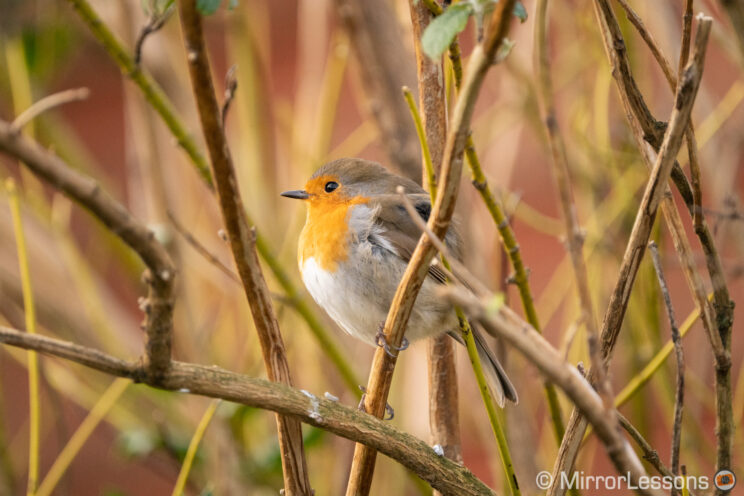In this post, we’re looking at two rather different cameras that are equally appealing to photographers, but for different reasons.
One is the Canon R7, an APS-C camera with high resolution, fast continuous shooting speed and a reasonable price, among other things.
The other is the Sony A7 IV, a full frame camera that packs excellent image and video quality.
Whether you’re here just out of curiosity, or you are seriously hesitating between these two cameras, I hope this article can be of help. Let’s begin!
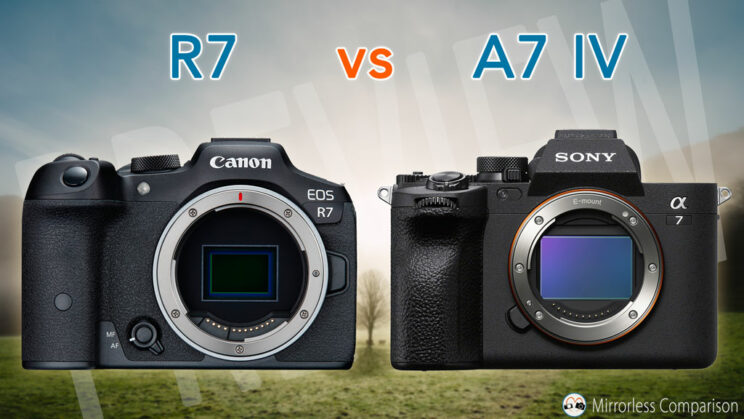
You might also be interested in:
Ethics statement: the following is based on our personal experience with the A7 IV, and official specs of the R7. We were not asked to write anything about these products, nor were we provided any compensation of any kind. Within the article, there are affiliate links. If you buy something after clicking one of these links, we will receive a small commission. To know more about our ethics, you can visit our full disclosure page. Thank you!
1. Sensor
The two cameras share a similar number of pixels, but the sensor format is different.
The R7 features an APS-C sensor with 32.5MP, whereas the A7 IV sports a full frame sensor with 33MP.
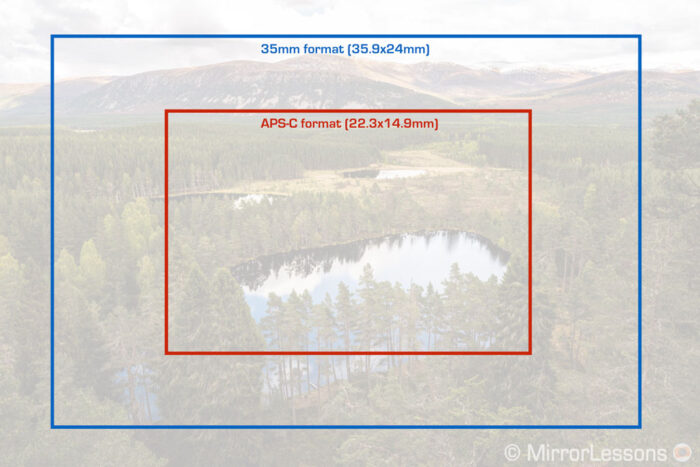
The Canon sensor is an updated version of the one found on the M6 II, with enhanced circuitry and micro lenses on the surface. That of the Sony is brand new and has a back-illuminated design (BSI).
The Sony has a vaster ISO range, as shown in the table below:
Camera
Normal range
Extended range
R7
100 – 32,000
100 – 51,200
A7 IV
100 – 51,200
50 – 204,800
The two cameras can also record 10-bit HEIF images, in addition to the usual JPG and RAW.
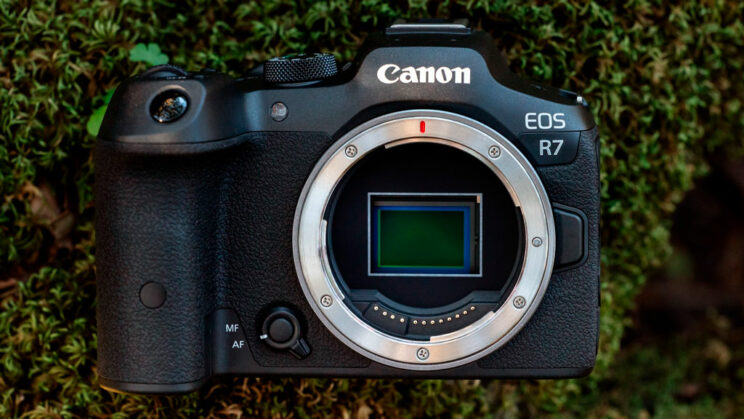
2. Autofocus
Both cameras come with advanced autofocus and tracking.
The R7 has the Dual Pixel CMOS AF II system with 100% sensor coverage and deep learning technology that allows the camera to track the eyes, head and body of humans, animals and birds, or track vehicles and the driver’s helmet in the case of motorcycles and open race cars. The algorithm is the same as the one found on the flagship R3 mirrorless camera.
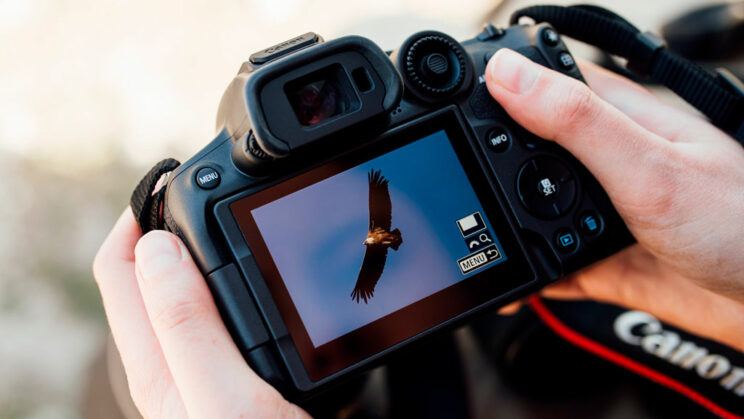
The A7 IV features real-time tracking and Eye AF that works for humans, animals and birds. There is no motorsport / vehicle detection however, and the camera doesn’t track heads or bodies for animals.
The R7 can work with a total of 5,915 points when the 1-point AF mode is selected, or 651 points when using Tracking.
The A7 IV uses 759 phase and 425 contrast detection points. The phase areas cover 94% of the sensor’s surface.
Concerning the sensitivity in low light, the Sony has a small advantage:
- A7 IV: -4Ev at f/2
- R7: -3.5Ev at f/2 (the official rating is -5Ev with a F1.2 lens)
Wildlife photographers will be pleased to know that the two cameras can work with phase detection and a small aperture down to f/22 in continuous shooting mode.
Among the extra features, the R7 can do focus bracketing and focus stacking in-camera, a possibility that is missing from the A7 IV.
3. Image stabilisation
Both cameras come with 5-axis stabilisation on the sensor.
The R7 has a higher rating of 8 stops of compensation, although keep mind it can be lower depending on the lens used. Still, on average it is higher than the 5.5 stops given to the A7 IV.
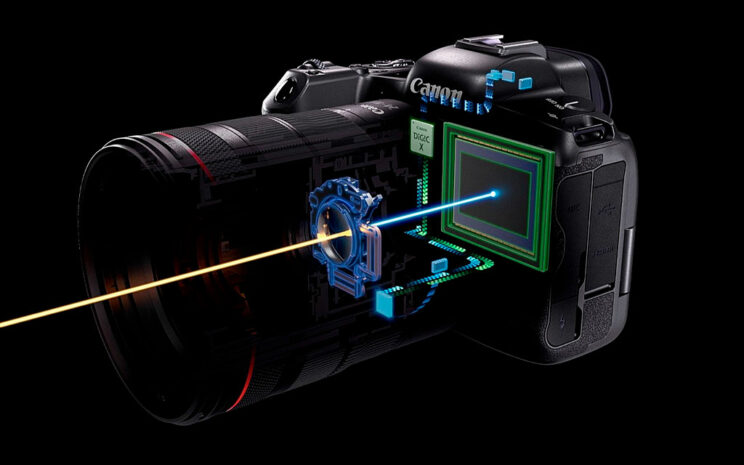
For video, you can activate digital stabilisation to improve the performance. Canon calls it Digital IS (there are two levels) whereas Sony calls it Steadyshot Active.
The A7 IV also has an extra options with Sony Catalyst. You can leave IBIS off on the camera, and stabilise the footage in post thanks to the software which is able to use the data from the camera’s gyro sensor. In my tests, this method proved to be the most effective when walking with the camera.
4. Continuous Shooting
Here we find another characteristic that differentiates these two cameras.
The R7 has superior speed with a maximum of 15fps when using the electronic shutter, or 30fps when using the electronic shutter. Furthermore, the camera has a pre-shooting mode that allows you to save up to 15 photos before the shutter is fully pressed.
The A7 IV manages 10fps with either the mechanical or electronic shutter, and doesn’t have extra features related to the drive speed.
The Canon also uses the electronic shutter to increase the maximum shutter speed to 1/16,000s (both max out at 1/8000s otherwise).
Below you can see what kind of performance the two cameras deliver when it comes to the buffer. For the Sony, there are two variations related to the type of card used (SD or CFexpress, more on this further down).
Buffer
R7
A7 IV
10fps (SD)
–
300+ JPG
50 RAW
10fps (CF)
–
300+ JPG
300+ RAW
15fps
224 JPG
51 RAW
–
30fps
126 JPG
42 RAW
–
Note: the A7 IV results are based on my own tests (measured in a duration of 30 seconds), whereas those of the R7 comes from the official specifications. For the Sony, RAW is intended as Compressed RAW. If you select Lossless or Uncompressed, the speed drops to about 6fps.
5. Video
Both cameras are capable of recording 4K video up to 60p, as well as 10-bit 4:2:2 internally.
The R7 can record 4K / 30p with the full width of the sensor (no crop) and with the oversampling method (from a 7K area), which guarantees the best quality.
If you want 4K 60p on the Canon, you have two options:
- no sensor crop, but the quality decreases (no oversampling)
- 1:1 pixel crop, meaning the camera records from a native 3840×2160 pixel area on the sensor, which translates into a severe 1.8x crop
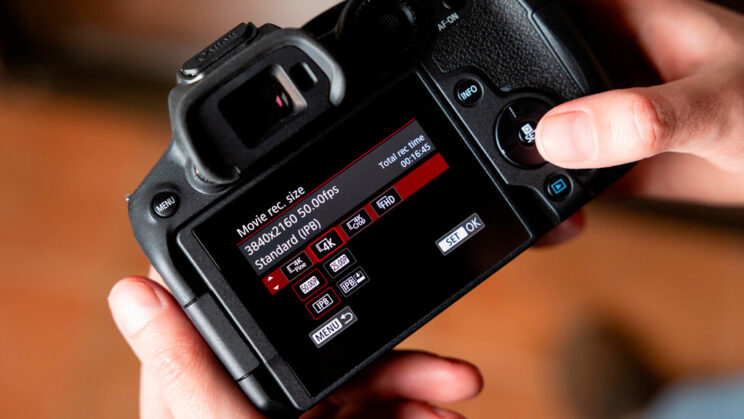
With the A7 IV, the behaviour is similar: up to 30p, there is oversampling from a 7K area without a crop. To work in 60p, the camera goes into Super35 mode (APS-C).
Obviously here the difference is that the Sony starts with a larger sensor, so all of the above can sound a bit confusing if we also take into account the crop factor of the two sensors. Below is an example to show how a 35mm lens would work on each camera depending on the sensor format as well as the settings used. Note that the APS-C crop factor is 1.5x on the Sony and 1.6x on the Canon.
35mm lens
R7
A7 IV
4K 30p
56mm
(APS-C crop)
35mm
4K 60p
56mm
(APS-C crop)
100mm
(APS-C + 1.8x crop)
52.5mm
(APS-C crop)
In Full HD, both cameras can record up to 120fps. The Sony offers two modes: S&Q where you get the slow motion result in camera, or in normal mode which means you record sound too (you’ll have to slow down the clip in post). On the R7, 120p works with the High Speed mode only (slow motion in camera, no sound).
The Canon can record 10-bit 4:2:2 interally, but only when selecting the C-Log3 or HDR PQ gamma. The A7 IV gives you a choice of 10-bit 4:2:0 (H.265) or 10-bit 4:2:2 (H.264) and you’re not contrastrained by the profile chosen. Futhermore, the Sony has more parameters to control the image thanks to the Picture Profiles that comes from the company’s professional cinema cameras.
I realise all these specs can be a lot to take in, so here is a second table that summarises them all:
R7
A7 IV
4K 30p
no crop
no crop
4K 60p
no crop /
1.8x crop
1.5x crop
Full HD
120p
120p
10-bit
H.265
H.264
H.265
Profiles
HDR PQ
C-Log3
S-Log2/3
HLG
Cinetone
Bitrate
200M (LGOP)
600M (ALL-I)
170M (8-bit)
340M (10-bit)
Rec. limit
No
No
Concerning long recording sessions, the A7 IV was able to record two hours of 4K 25p without interruption (ambient temperature of 21˚C).
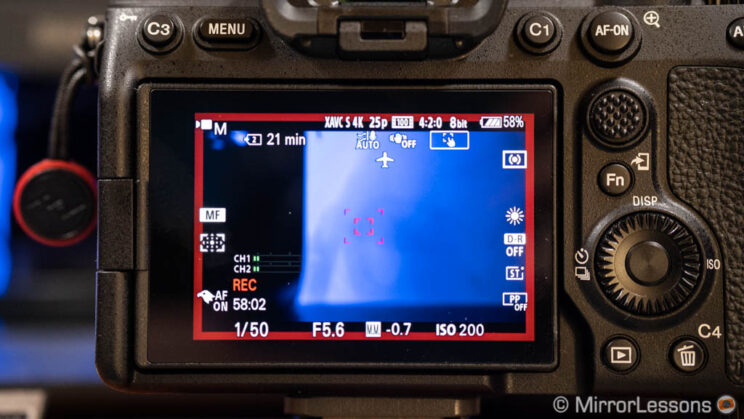
The first reviews of the R7 are encouraging, considering the bad reputation it got with the R5 and R6. For example, Gordon Laing was able to record for more than an hour in 4K 30p (maximum quality).
Finally, both cameras have microphone and headphone sockets, and they can also record digital audio (with compatible microphones) via their multi-function shoe.
6. Design and Controls
The two cameras are quite close in terms of size and weight. The R7 is ever so slightly larger while the A7 model is a bit heavier. The two include weather-sealing.
- R7: 132.0 x 90.4 x 91.7mm, 612g
- A7 IV: 131.3 x 96.4 x 79.8mm, 658g
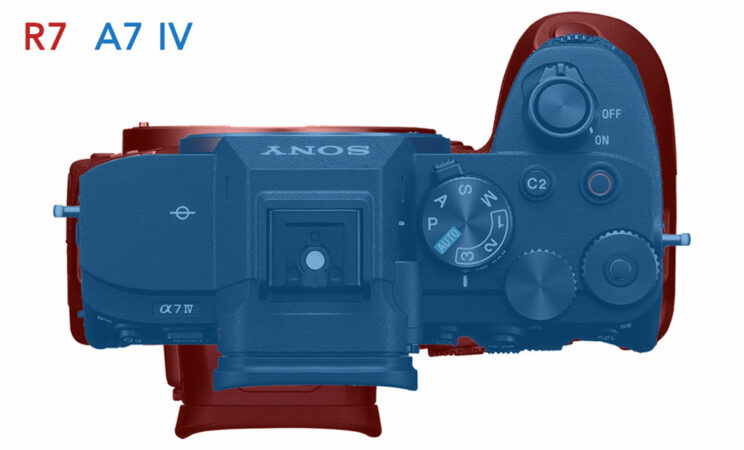
The A7 IV features four dials that can be used to control every aspect of the exposure (once configured that way), whereas the R7 has only two.
Another interesting characteristic of the Sony design is the lever underneath the main shooting dial that allows you to switch between photo and video mode. This also means you can use the custom modes on the main dial for video, if you wish.
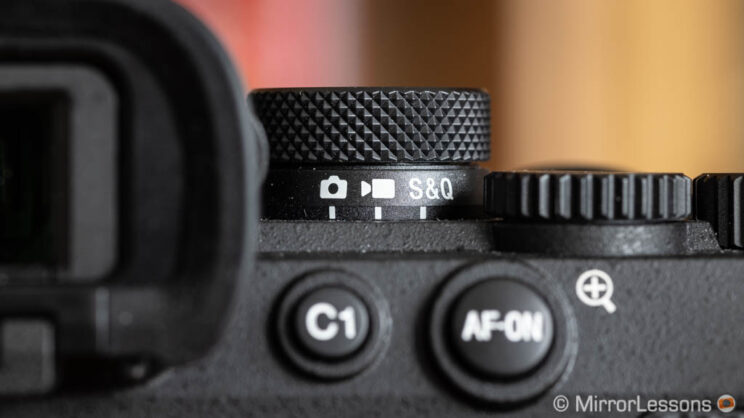
Both cameras have an AF Joystick. It’s intersting to highlight the unusual solution Canon came up with: the joystick is found inside the large rear dial.
Finally, the R7 has a focus lever at the front.
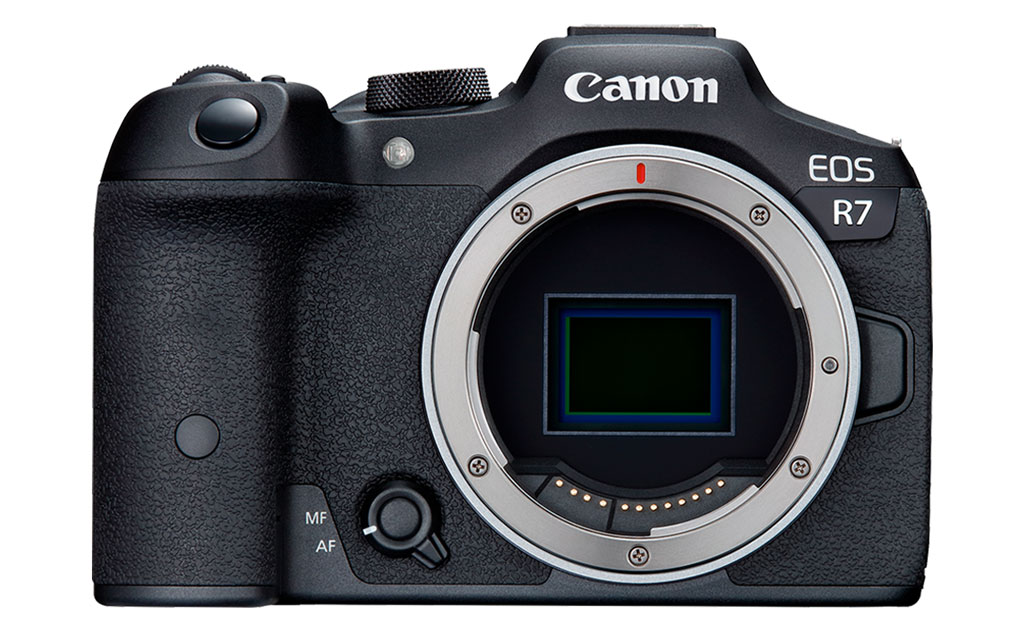
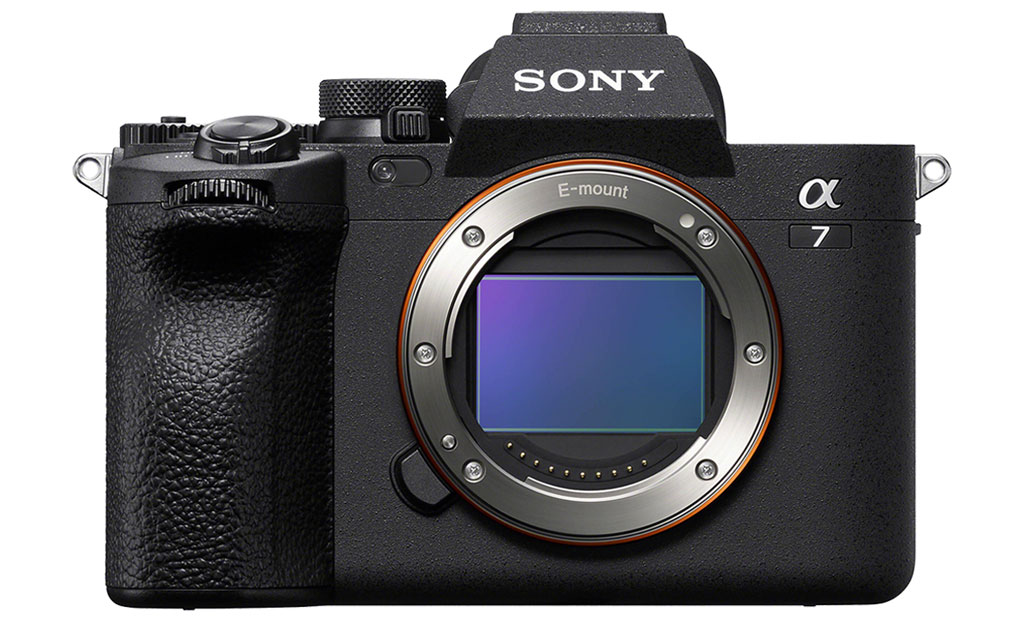
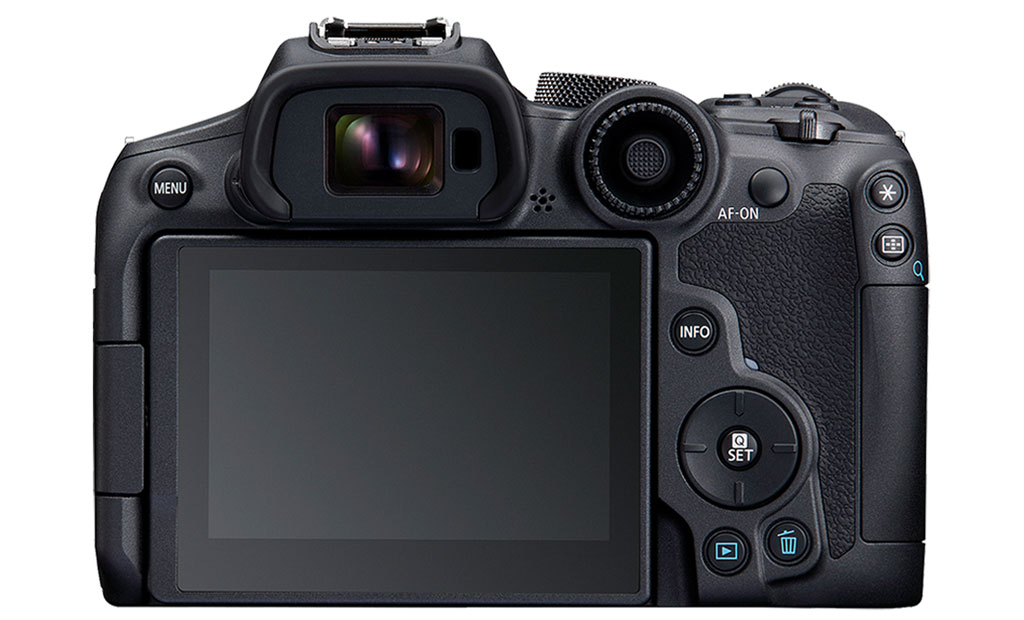
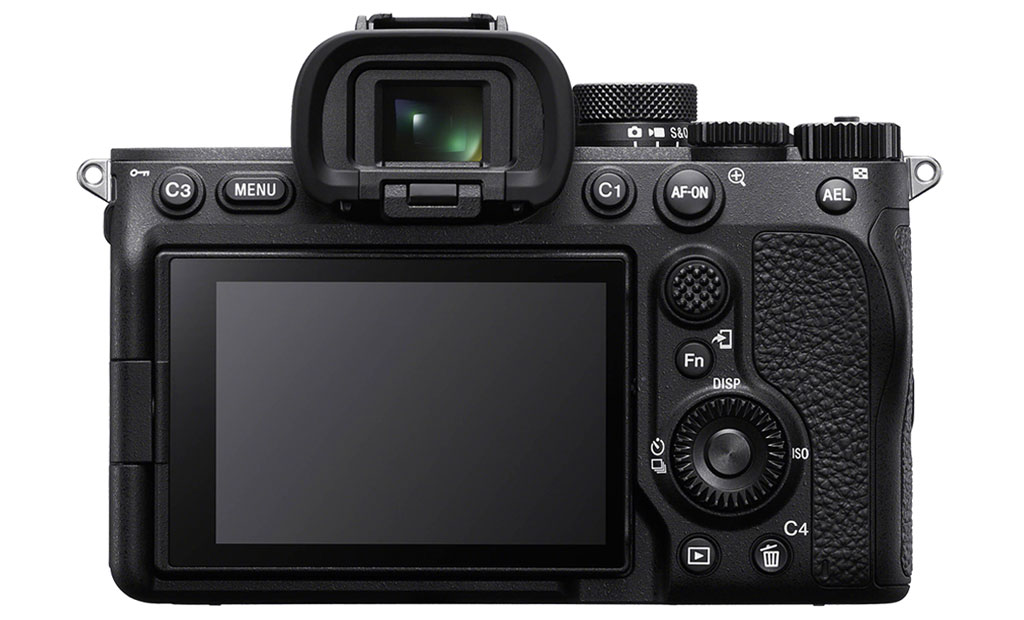


7. Viewfinder and LCD
The A7 IV has a larger viewfinder with better magnification and more resolution too. Here is how they compare:
EVF
R7
A7 IV
Panel
0.39-in OLED
0.5-in OLED
Resolution
2.36M
3.69M
Refresh rate
120Hz
120Hz
Magnification
0.72x
0.78x
Eyepoint
22mm
23mm
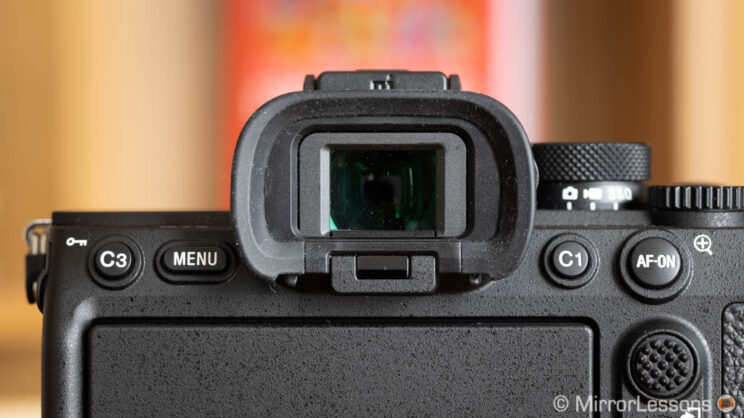
As for the LCD screen, they both have a multi-angle mechanism and the same 3.0-in size. That of the Canon has more resolution: 1.62M vs 1.04M dots.
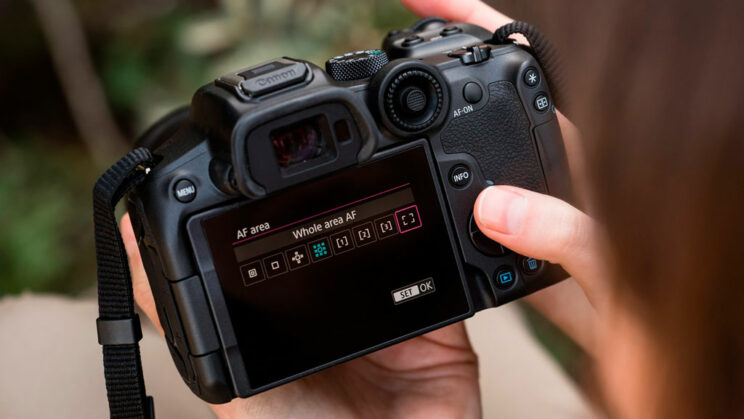
8. Cards and Battery
Both cameras can use two memory cards at the same time, and they can be two SD UHS-II cards.
On the A7 IV, you also have the option of using a CFexpress Type A card in the first slot. This card is smaller (but slightly thicker) than SD cards, and offers considerable faster writing and reading speed. You will need one to get superior buffer capabilities, or if you want to record 4K 60p at the highest bitrate with the S&Q mode. As you can imagine, CFexpress cards are more expensive.
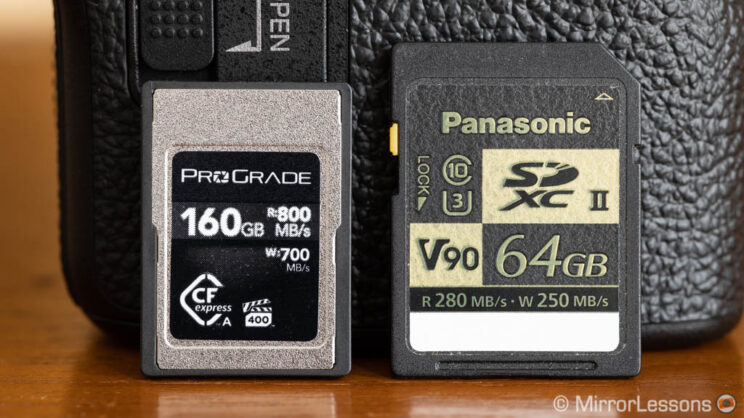
Moving on to the battery life, the R7 does better: it has an official rating of 770 frames, whereas the A7 IV does 610 images (when using the LCD, by CIPA standards).
Both cameras can be powered or charged via the USB-C port. In the case of the A7 IV, there is also a battery grip option.
One annoying thing about the Sony is that the battery charger is not supplied, only the USB cable and wall plug.
9. Lenses
As always when comparing two cameras belonging to two different systems, it is important to talk about the lenses.
The R7 is the first APS-C camera designed with a RF mount (alongisde the R10 that was announced at the same time). Prior to this, Canon only focused on full frame, keeping its other APS-C mirrorless system separate (EOS M). At the time of publishing this article, there are only two native APS-C lenses designed for the R7: the 18-45mm kit lens and the 18-150mm ‘all-rounder’ lens.
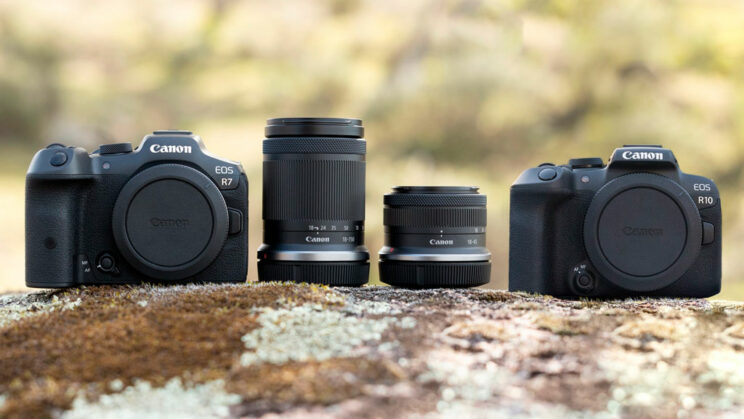
If you want to do more with your camera, you’ll have essentially two options while we wait for more APS-C lenses to come:
- use full frame RF lenses. There is a good selection nowadays (with more to come). Some of them are affordable and with telephoto lenses especially, you can take advantage of the crop factor to get extra reach.
- use the EOS R to EF adapter and get access to all the DLSR lenses produced by Canon and third-parties (APS-C and full frame lenses).
If you only look at native lenses, a.k.a. lenses designed for mirrorless cameras and not adapted lenses, the A7 IV has an advantage. The system is older (2013 vs 2018 for Canon) and not only do you get a great selection from Sony itself, but the support from third party manufacturers is growing by the day, especially for popular brands such as Sigma, Tamron and Samyang. There is choice for every budget and need.
Sony also has an APS-C segment, using the same E-mount. Although it might be less interesting for your A7 IV, it’s still something worth knowing in case you want to expand your gear to include an APS-C model (or want to record 4K 60p, which only works with the APS-C crop).
Finally, you can adapt Canon’s EF lenses to the A7 IV as well. There are many third-party adapters that retain automations such as autofocus and exposure. The performance is not as fast as using EF lenses on the R7, but it’s more than decent for many applications. There are also adapters for Nikon F lenses, and even adapters that give autofocus to Leica M lenses.
10. Price
This is certainly one of the decisive factors when choosing between these two cameras, and the difference in price is not small.
The R7 can be found for $1500, £1350 or €1570 for the body only.
The A7 IV is more expensive with prices starting at $1500, £2400 or €2800.
Note: prices as of early June 2022.
You might also be interested in:
Conclusion
I’ll say it before you say it: these two products don’t play in exactly the same league. Aspects such as price or sensor size will be enough for many to decide which one they prefer.
Is there any real reason to hesitate between these two cameras, given all the differences? I think it depends on the genre you like to practise as a photographer.
The R7 could strike a nice balance between price and performance. Wildlife and sports photographers could take advantage of the crop factor to get extra reach, and the camera has an advanced autofocus and enough drive speed to cover most of their needs. If the 32MP sensor delivers good dynamic range and decent high ISO, I can see this model becoming popular in this category.
If you’re not interested in nature or action, and don’t have the budget for the A7 IV, I think there might be other options to look at, like a used Sony A7 III or even a Fujifilm X-T4 that offers a more complete catalogue of native APS-C lenses. The R7 can make sense if you want to enter Canon’s RF mount system, and perhaps you already have EF lenses that you can use with the adapter.
The A7 IV is a jack of all trades. It has great image quality, whether you do landscapes, portraits or nature, an excellent autofocus system and top-of-the-class video capabilities. You also get a better viewfinder and, more important, access to a vast list of native E-mount lenses for every need and budget. Only the continuous shooting speed falls a bit behind for a camera of this kind.
Reminder: the links below are affiliate links. If you decided to buy something after clicking the link, we will receive a small commission.
Check the price of the Canon EOS R7 on
B&H Photo
Check price of the Sony A7 IV on
Amazon | Amazon UK | B&H Photo | eBay

